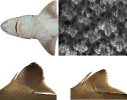Squalus montalbani
Whitley, 1931
Indonesian greeneye spurdog
Classification: Elasmobranchii Squaliformes Squalidae
Reference of the original description
New names for Australian fishes. Australian Zoologist, 6(4), 310–334
New names for Australian fishes. Australian Zoologist, 6(4), 310–334
Image of the original description
No image in first description.
No image in first description.
Synonyms / new combinations and misspellings
Squalus cf. montalbani, Squalus philippinus
Squalus cf. montalbani, Squalus philippinus
Description :
Citation: Squalus montalbani Whitley, 1931: In: Database of modern sharks, rays and chimaeras, www.shark-references.com, World Wide Web electronic publication, Version 01/2026
Please send your images of "Squalus montalbani" to info@shark-references.com

Lateral view of: Squalus montalbani from Indonesia (MZB 15424, female 945 mm TL); In: Last, P.R. & White, W.T. & MOTOMURA, H. 2007 Part 6 - A description of Squalus chloroculus sp. nov, a new spurdog from southern Australia, and the resurrection of S. montalbani Whitley. CSIRO Marine and Atmospheric Research Paper, 14: 55-69

Lateral view of: Squalus montalbani from Indonesia (MZB 15424, female 945 mm TL); In: Last, P.R. & White, W.T. & MOTOMURA, H. 2007 Part 6 - A description of Squalus chloroculus sp. nov, a new spurdog from southern Australia, and the resurrection of S. montalbani Whitley. CSIRO Marine and Atmospheric Research Paper, 14: 55-69
Common names
 Indonesian greeneye spurdog
Indonesian greeneye spurdog
 Indonesian greeneye spurdog
Indonesian greeneye spurdog
Short Description
This large species of the ?mitsukurii group? is distinguished by the following set of characters: body elongate to robust, trunk depth 8.9-13.4% TL (mean 11.4% TL, n=14); snout is broadly triangular, with mouth width 1.69-2.32 (1.85) times the horizontal prenarial length; pre-first dorsal length 26.5-30.7 (29.0)% TL; pre-second dorsal length 57.6-62.8 (60.8)% TL; interdorsal space 21.7-25.9 (23.7)% TL; low raked dorsal fins; second dorsal-fin length 11.1-13.9 (12.4)% TL, height 3.4-4.6 (4.0)% TL, inner margin length 4.0-5.9 (4.8)% TL; second dorsal-fin base 15.8-21.3 (20.8) times the base of second dorsal spine; pre-pectoral length 20.8-22.9 (22.0)% TL; pelvic-caudal space 22.9-26.0 (24.0)% TL; caudal bar is almost upright, extending broadly from the caudal fork up the poster or margin of the upper lobe for about 0.6 of its length in immature specimens, upper caudal fringe forming a deep saddle along midlength of lobe; flank denticles tricuspid; monospondylous centra 41-47 (mainly 42-44), precaudal centra 79-85, total centra 105-114 [3332].
This large species of the ?mitsukurii group? is distinguished by the following set of characters: body elongate to robust, trunk depth 8.9-13.4% TL (mean 11.4% TL, n=14); snout is broadly triangular, with mouth width 1.69-2.32 (1.85) times the horizontal prenarial length; pre-first dorsal length 26.5-30.7 (29.0)% TL; pre-second dorsal length 57.6-62.8 (60.8)% TL; interdorsal space 21.7-25.9 (23.7)% TL; low raked dorsal fins; second dorsal-fin length 11.1-13.9 (12.4)% TL, height 3.4-4.6 (4.0)% TL, inner margin length 4.0-5.9 (4.8)% TL; second dorsal-fin base 15.8-21.3 (20.8) times the base of second dorsal spine; pre-pectoral length 20.8-22.9 (22.0)% TL; pelvic-caudal space 22.9-26.0 (24.0)% TL; caudal bar is almost upright, extending broadly from the caudal fork up the poster or margin of the upper lobe for about 0.6 of its length in immature specimens, upper caudal fringe forming a deep saddle along midlength of lobe; flank denticles tricuspid; monospondylous centra 41-47 (mainly 42-44), precaudal centra 79-85, total centra 105-114 [3332].
Distribution
Eastern Indian Ocean to Pacific: Philippines, Indonesia to Australia. Source: www.gbif.org
Eastern Indian Ocean to Pacific: Philippines, Indonesia to Australia. Source: www.gbif.org
Remarks
shark-references Species-ID=6798;
shark-references Species-ID=6798;


















